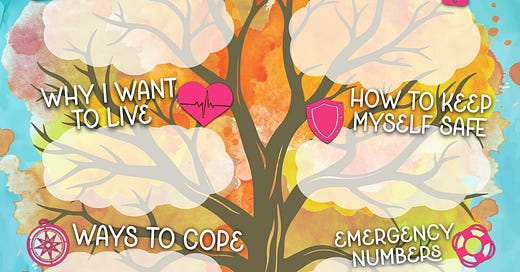Hello! Before I focus on today’s main topic, I want to share that I’m teaching a Cultivating Hope with Suicidal Clients course for clinicians. It’s virtual, 8 CEs, and begins this Wednesday (5/7). If you're interested in signing up, the details are here. This will also be offered on-demand through Praxis CET if you can’t make it to the live course.
Now, I want to pivot to a really important, science-supported suicide prevention intervention called Safety Planning. Drs. Stanley and Brown developed this intervention for people to use while navigating suicidal crises. The basic idea is that when suicidal thoughts and urges take over, it’s especially hard to think clearly enough to navigate crises. Access to a detailed safety plan, typically created in collaboration with a clinician, can empower suicidal people with tools and guidance when they most need them. An adapted version of the original safety plan is pictured below (fillable pdf here; art by Icon & Ink).
As you can see above, safety or crisis plans involve a single document (either digital or on paper) containing different types of information. I’ll briefly describe the purpose of each section. For more details, please check out this resource.
Warning Signs: What tells you that you’re entering a suicidal crisis? Some common warning signs include isolation, making suicide plans, agitation, hopelessness, social withdrawal, sleep disturbance, increased substance use, and feeling trapped. Listing your personal warning signs in a crisis plan can help you to recognize when you need to intervene. It can also be helpful to share your warning signs with your therapist and trusted love ones so they can look out for them too.
Who Can Support Me: No one should have to navigate an emergency on their own. Who can you list in this section? Think about the people who can show up for you and support you in a crisis. Include their names and phone numbers in this section. It can also be helpful to let people know they are in your crisis plan and what you would find most supportive in your time of need.
Why I Want to Live: When suicidal thoughts take over, it can be hard to recall your reasons for holding on. This section serves as a reminder for why you want to live. Do you want to live to stay connected to other people, to see what the future brings, to care for your pets, to witness something you’re looking forward to? No reason is too small and here are some ideas if you’re unsure.
How to Keep Myself Safe: Research shows that putting time and distance between yourself and lethal means can be lifesaving during a suicidal crisis. How can you make your environment safer? If you have firearms, sharps, medications, or other potentially dangerous methods for suicide, list how you can secure them and distance your self from them during a crisis. Can you put them in a safe? Can a trusted person hold on to them until your crisis passes? For other ideas, please check out this list of resources.
Ways to Cope: Suicidal thoughts often arise from a deeply felt sense of pain. How can you cope with the pain and suicidal thoughts in ways that are helpful and healthy? Do you find distraction, talking to a friend, engaging in a hobby, self-compassion, or other tools especially helpful (e.g., dialectical behavior therapy skills)? Those can be written as reminders in this section.
Emergency Numbers: Finally, all safety/crisis plans should include emergency numbers such as 988 Lifeline or those found in this directory. You can also include the address for your local emergency room, a local mobile mental health unit, or other options.
I hope this brief overview of safety planning has been helpful. Once a safety plan is complete, it can be printed out and kept somewhere close (e.g., your wallet) and/or stored as a digital file on a phone. The key is to make sure it is accessible to you at all times. As always, this post is for educational purposes only, and I highly recommend checking in with a mental health professional or contacting one of the crisis lines (e.g., 988) for more personalized assistance in creating your own safety plan.
Thank you for reading! I hope your week goes well.




